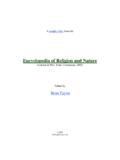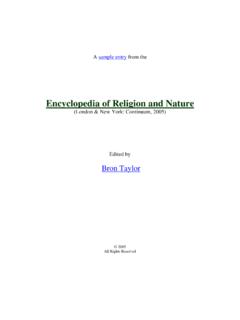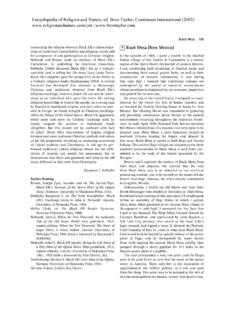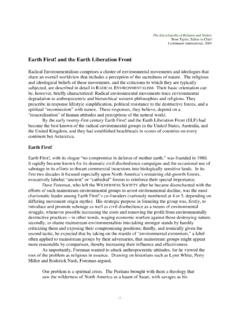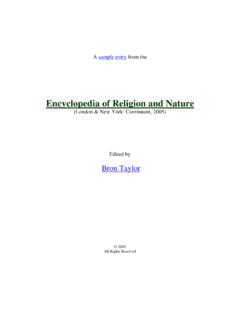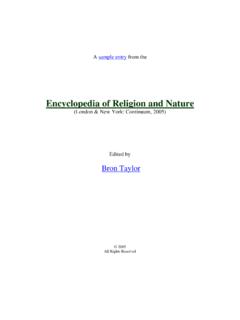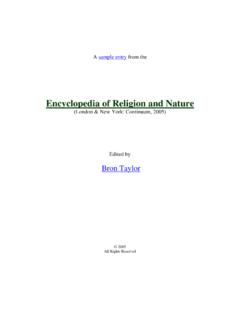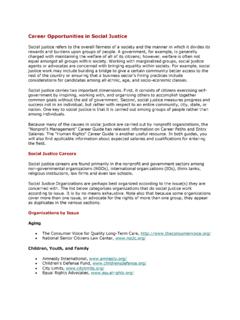Transcription of Encyclopedia of Religion and Nature
1 A sample entry from the Encyclopedia of Religion and Nature (London & New York: Continuum, 2005) Edited by Bron Taylor 2005 All Rights Reserved NNaess, Arne (1912 )In a lecture in Bucharest in 1972 the Norwegian philo-sopher Arne Dekke Eide Naess made the now famousdistinction between the shallow ecology movement andthe deep, long-range ecology movement. He has sinceremained one of the major international voices of deepecology. Naess originally gained his reputation inphilosophy from work in semantics, but he has also pub-lished several books on Gandhi, and on Spinoza, skepti-cism and philosophy of science.
2 Naess identified, on theone hand, a shallow ecology movement that foughtagainst pollution and resource depletion for anthropo-centric reasons. Pollution and resource depletion werewrong because they threatened human health and afflu-ence. The deep ecology movement, on the other hand,favors some form of biocentric egalitarianism as a guide-line for environmental action. This distinction betweenanthropocentric and biocentric environmentalism is at theheart of deep ecology. Deep ecology therefore is a critiqueof a commonly held doctrine that the natural world hasvalue only insofar as it is useful to main eco-philosophical work was published in1989 as Ecology, Community and Lifestyle, which wasbased on the Norwegian kologi, samfunn og livsstil,issued in 1976.
3 Naess has also contributed to the develop-ment of environmental philosophy in numerous articlesand speeches and through action. The political programof deep ecology was formulated in the Deep EcologyPlatform formulated by Arne Naess and George Sessionsin deep ecology questioned a dominating culturalparadigm, that of excessive anthropocentrism, it couldclaim to rely on a deeper level of argumentation thanshallow ecology, that is, on the level of Religion andphilosophy. A worldview that can support the deepecology platform is called an ecosophy, a term coined byNaess.
4 A variety of religions and philosophies can havethis function, but many are probably too personal ecosophy is called Ecosophy T. T standsfor his mountain cottage, Tvergastein, and points to thepersonal Nature of ecosophies. Naess himself ascribesthe origin of central values of his ecosophy to importantchildhood experiences. He used to spend hours at the ageof four observing the ecosystem on the coastline, and atthe age of eight he became attached to a particularmountain. What he calls shore-life philosophy values richness, diversity, multiplicity, equivalence, equivalidity,egalitarianism, peacefulness, cheerfulness and alsoskepticism (Naess 1983: 211).
5 The mountain became forhim a symbol of a benevolent, equiminded, strong father (Naess 1983: 212). The love of this mountain reduced the need for anything supernatural, and helearned to value austerity, toughness, distance and aloof-ness (Naess 1983: 213).Early on, Naess came under the influence of the ethicsof nonviolence of Mahatma Gandhi, and the Gandhianinfluence on Ecosophy T is significant. Naess ecologicalviews are based on childhood experiences but they areshaped by, and a continuation and further developmentof, his Gandhian beliefs.
6 The key concept of Naess ecosophy is self-realization. Self-realization is theultimate norm of his eco-philosophical system. Accordingto Ecosophy T, all living beings are capable of self-realization. The concept of self-realization in Naess philosophy has developed from his lifelong engagementwith the philosophy of Gandhi. In one of his manybooks on Gandhi, Naess explains that, according toGandhi, self-realization was the final goal of life. Thiswas attained by a gradual perfection.
7 All that humans do,say and think should have this self-realization as its also believed in the unity of life. To explainthe central concept of self-realization and the matureexperience of oneness in diversity in his ecologicalwritings, Naess quotes the famous Hindu text Bhaga-vadgita, verse Bhagavadgita was Gandhi s mostsacred book, a source of wisdom he turned to wheneverhe needed to solve ethical dilemmas. Naess use of theBhagavadgita has to be understood in this Gandhiancontext.
8 Verse describes the yogin who sees himselfas in all beings and all beings in himself (or self accord-ing to Naess) and who sees the same everywhere. Bhagavadgita sums up, according to Naess, themaximum of self-realization. It expresses the idea that allis connected to everything else and therefore that theself-realization of any living being is part of the self-realization of each one of ecosophy of Arne Naess as it is presented in hiswritings draws on the close connection between non-violence (ahimsa), the philosophy of oneness (advaita) andthe goal of self-realization (moksha) in the religiousthought of Gandhi.
9 Naess understands the Bhagavadgitato say that solidarity with all beings and nonviolencedepends on widening one s identification and that to seethe greater self means to expand one s identification toinclude all living beings as one s finds the same doctrine of self-realization andunity of life expressed also in the philosophy of to Spinoza s philosophy, every living beingtries to realize its potential, its power or essence. Unity ofnature means that everything is connected to everythingelse and that therefore the self-realization of one livingbeing is part of the self-realization of all other uses Gandhian concepts to exemplify the similaritybetween Spinoza s philosophy and Gandhian argues that adherence to Spinoza s system isconsistent with being a karma-yogi (Naess 1980: 323).
10 Karma-yogi is here a concept borrowed from , who was a great influence on how Hinduismwas received in the West, held that the Hindu asceticsshould perform social service (seva). This new ideal hecalled karma-yoga. Gandhi was a foremost practitionerof this new ideal. He made social service a necessity forself-realization. Ecosophy T combines twentieth-centuryreinterpretations of Hindu asceticism by Gandhi andVivekananda, the philosophy of Spinoza, and a belief inthe world as the ultimate concern typical of religiousenvironmentalism.

